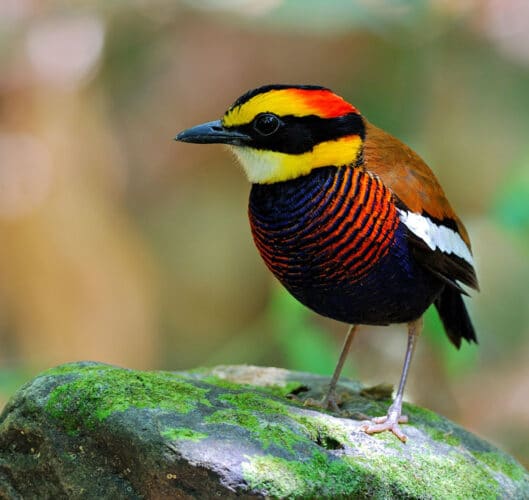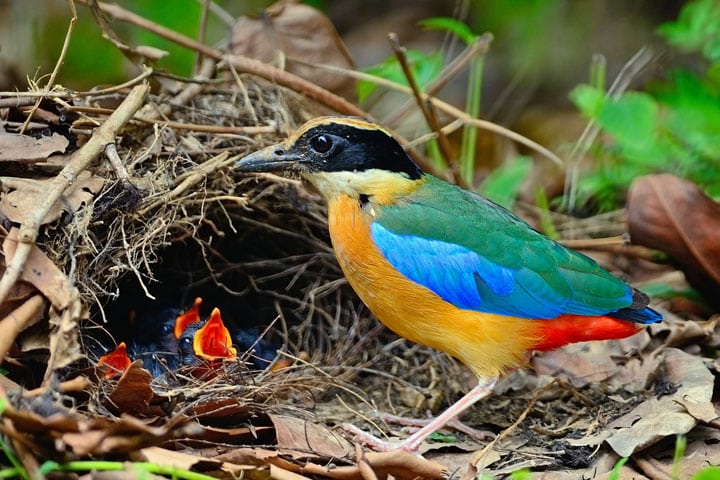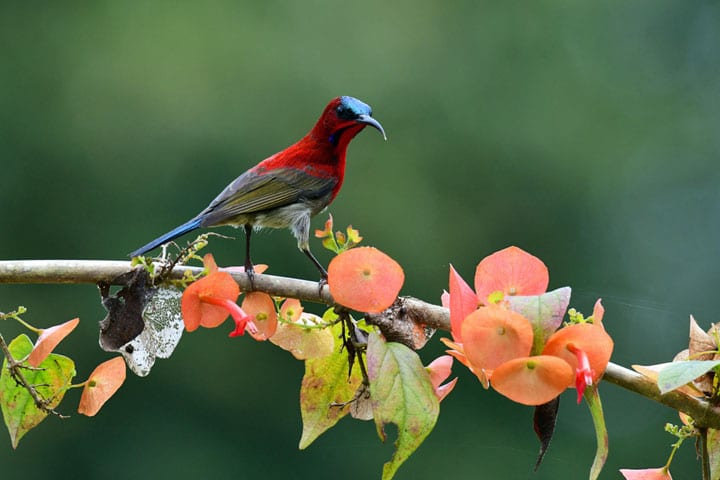Bird watchers in Thailand

Birding is watching, identifying (name); counting birds; making an inventory of bird areas and conducting research into, for example, behavior and ecology.
The practitioners of this hobby are called bird watchers, more formally referred to as amateur ornithologists. In simple words, a bird watcher is someone who watches birds. In fact, you don't need much to do that: good observation skills, a bird guide and sometimes binoculars.
A friend of mine regularly went into the dunes around Schoorl, looked for a nice spot to sit and could stay there for hours to watch birds. Of course he also wanted to see special birds, but the most important thing for him was the experience of nature, in which he – as he told me – came to rest completely.

Banded Pitta
My wife also did some birding. When she was busy with her hobby ceramics in our garden room in Alkmaar, she saw all kinds of ordinary Dutch birds in our always flowery garden, house sparrow, robin, tits, crows, etc. She especially liked to observe the behavior of those birds, for example as they built a nest in one of our trees or shrubs, to “study”
Birding can be done anywhere in the world, including Thailand. Vogelen, not to be confused with the German vögeln, because that means something completely different. That sport can also be practiced in Thailand, but that is not what this story is about.
Travel for birdwatchers to Thailand is a growing market. More and more Dutch birdwatchers combine their sun holiday with excursions to areas where many unknown birds occur. You can go individually or in groups and there are several websites that offer birding tours.
At those bird areas – as I read on one of those websites – Pak Tale, among others, is called the new hot spot of Thailand, located southwest of the capital Bangkok. Thousands of waders are present at these salt pans. Every winter there is a mythical species among them: the spoon-billed sandpiper. It is a breeding bird of the Arctic tundra, which unfortunately appears to be on the verge of extinction.

But Pak Tale has much more. In recent years, mysterious plovers have been sighted in Southeast Asia that have tentatively been given the 'working name' White-faced Plover. The rare Malaysian Plover also roams around here, and what about the very rare Nordmann's Green-legged Sandpiper that overwinters here in small numbers? Or Big Knots? It once again demonstrates the value and potential of this area.
Another well-known area is Khao Yai, a beautiful national park with tropical hillside forest, a few hours north of Bangkok. The good infrastructure makes it easy to bird from the road, which can produce beautiful species such as Silver Pheasant and Siamese Fireback. Sometimes Great and Wreathed Hornbills fly over, immense hornbills. There is an extensive network of forest trails that are great for birdwatching. Options include beauties such as Long-tailed and Silver-breasted Broadbill, Blue Pitta, various laughingthrushes and barbets, Blue-bearded Bee-eater and Siberian Blue Robin.
Of course, Doi Inthanon in Chiang mai should not be missed. In this national park with the highest mountain (2.565 meters) in Thailand, you can bird at different heights. Along the water in the lower parts are the beautiful White-capped and the Plumbeous Water Redstart and in these parts is also the Collared Falconet, a miniature falcon. At the top of the mountain is a forest, where specialties such as the Pygmy Wren Babbler, Green-tailed Sunbird, Rufous-winged Fulvetta, Chestnut-tailed Minla, White-browed Shortwing, Chestnut-crowned Laughingthrush and Yellow-cheeked Tit can be spotted .

Also called Huai Hong Krai, where the endangered Green Peacock still lives. Finally, further north, to Doi Ankhang, a beautiful mountain forest on the border with Myanmar. The Crested Finchbill, Slaty-backed and the beautiful White-gorgetted Flycatcher are quite common. With some effort, the spectacular Red-faced Liocichla, Silver-eared Mesia and Spot-breasted Parrotbill can be seen there. Rarities include the endangered Hume's Pheasant and Giant Nuthatch05
These are just a few examples where the bird watcher can spot the birds to his heart's content, whether or not under expert and locally known travel guides. Thailand, so also a country for these enthusiasts.
I will come back to that German bird for a moment. A (very old) German Witz goes like this: A man catches his wife upstairs in the bedroom with another man. He becomes furious, grabs the man by the head and butt and throws him out the window and adds: "Kannst Du vögeln, kannst Du fliegen auch"


The spoon-billed sandpiper is not a mythological bird.
In 2011 and 2018 I was able to see one each time.
Of course you won't see them if you don't have a decent pair of binoculars or a telescope (preferably both).
Without this equipment you won't have to write much in your field book.
Don't forget about Sam Roi Yot! See http://www.samroiyotbirding.weebly.com
Bung Bhorapet (Nakhon Sawan) is very well known, the largest natural freshwater lake in Thailand where numerous migratory birds from Siberia come to spend the winter. That it is also beautiful vast Lotus fields is an extra takeaway
Vogelen means something else in Flemish than watching birds ...
Dear Gringo, the article is very interesting, but my question has nothing to do with the content, but with your familiarity with the Thai birdwatching world. Are there falconers in Thailand? The pigeon terror in our village is running out of steam. Thanks for the response in advance.
No, I don't know anything about the Thai birdwatching world.
Or the “pigeon terror| I doubt it can be solved with falconers.
I would say, describe that pigeon terror a bit more clearly, what are they
for pigeons, how many are there, are they constantly present. what consists of
their terror and all.
Send it to the editor [email protected]who wrote an article about it
can write and ask blog readers for a solution for your .
Thanks for the response Gringo.
Dear Gringo,
Could you or someone else name the very beautiful birds from nr.1?
Preferably not a Latin name but a "generally" used name.
Thanks!
Dear Lodewijk, that is a chestnut-headed bee-eater that falls under the fruit and insect eaters: https://voliere-info.nl/ringmaten-vruchten-en-insecteneters/
Dear Peter,
Thank you! Do you perhaps also know the names of the 3 other birds?
Regards,
Lodewijk
The second photo: Banded Pitta
The third: Blue-winged Pitta
the fourth: Crimson Sunbird – Yellowback Sunbird
I see these bee-headed birds every day sitting on my barbed wire, the males have a reddish-brown head and bright green breast and the females are a bit pale green, they always make a dive and float back with a graceful arc.
more names of birds in Thialand can be found at https://en.wikipedia.org/wiki/List_of_birds_of_Thailand
Thank you very much for both responses!
A person is never too old to learn!
Someone who is interested in birds and other animals in nature needs good quality binoculars. Does anyone know where to get something like this in Thailand and by that I mean binoculars from brands such as Nikon, Zeiss, Leitz, Bushnell, etc. I've been looking for a while now but can't find anything.